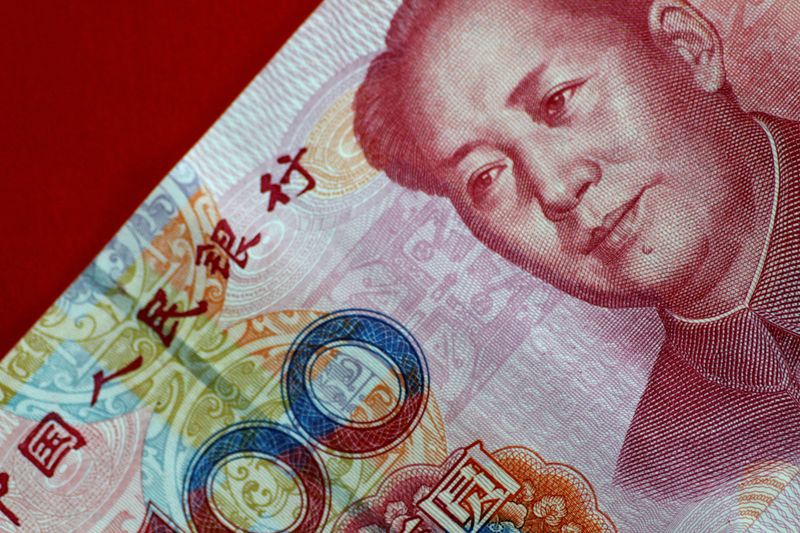
By Kevin Yao and Ethan Wang
BEIJING (Reuters) -China’s new yuan loans contracted in July for the first time in 20 years as the economy struggled, falling well short of analysts' forecasts, but improvements in broader credit growth suggest the central bank is in no rush to ease policy.
While new loans typically fall in July after strong gains in June when banks strive to meet quarterly targets, the latest reading was well below even the most pessimistic analyst's forecasts, pointing to weak private sector demand as Beijing tries to negotiate a durable trade deal with Washington.
"The July credit data was weak, but money supply exceeded expectations, reflecting the impact of last year’s low base and debt resolution efforts," said Xing Zhaopeng, senior China strategist at ANZ.
"At present, monetary policy has entered a period of observation, and a rate cut is unlikely in the short term. From the perspective of liquidity needs, a reserve requirement ratio (RRR) cut could also be delayed. Structural monetary policy remains the main tool for easing."
New yuan loans contracted by 50 billion yuan ($6.97 billion) in July, falling well short of analysts' forecasts and plunging from 2.24 trillion yuan in June, according to Reuters calculations based on data released by the People's Bank of China.
That marked the first contraction since July 2005 and the largest monthly decline since December 1999, according to central bank data.
Analysts polled by Reuters had expected new yuan loans last month to reach 300 billion yuan, compared with 260 billion yuan a year ago.
Along with seasonal trends which buoyed June's tally, credit demand also had rebounded sharply that month as sentiment improved following rounds of trade talks in Europe and a tentative easing of trade tensions with the U.S.
The central bank does not provide monthly breakdowns. Reuters calculated the July figures based on the PBOC's January-July data released on Wednesday, compared with the January-June figure.
In the first seven months of the year, banks extended 12.87 trillion yuan in new loans, versus 12.92 trillion yuan in January-June, implying a net reduction of 50 billion yuan in July.
Banks issued 13.53 trillion yuan in new loans in the same period last year.
Household loans contracted 489.3 billion yuan in July, versus a rise of 597.6 billion yuan in June, according to Reuters calculations, as a prolonged property market crisis showed no signs of easing. Corporate loans plunged to 60 billion yuan from 1.77 trillion yuan in June.
The PBOC release did not give any explanations for changes in credit trends.
PBOC IN WAIT-AND-SEE MODE
China’s economy slowed less than expected in the second quarter due in part to policy support and as factories took advantage of a U.S.-China trade truce to front-load shipments. But analysts warn the second half will be tougher as weak domestic demand, the property slump and rising global trade risks ramp up pressure on Beijing.
The United States and China agreed early this week to extended their tariff truce for another 90 days, staving off triple-digit duties on each other's goods, but business confidence remains fragile, with some factories cutting selling prices, shifts and workers' pay.
On Tuesday, China announced it would offer interest rate subsidies for businesses in eight consumer service sectors, as well as for individual consumers. Eligible businesses and consumers can receive an annual interest subsidy of one percentage point on loans.
Beijing has ramped up infrastructure spending and consumer subsidies, alongside steady monetary easing. In May, the central bank cut interest rates and injected liquidity as part of broader efforts to cushion the economy from Trump's tariffs.
Wednesday's data also showed outstanding yuan loans rose 6.9% in July from a year earlier, slowing from 7.1% in June and hitting a record low. Analysts had expected 7.0% growth.
Broad M2 money supply grew 8.8% from a year earlier, above analysts' forecast of 8.2%. M2 expanded 8.3% in June.
The narrower M1 money supply rose 5.6% year-on-year, compared with 4.6% in June.
Outstanding total social financing (TSF), a broad measure of credit and liquidity in the economy, rose 9.0%, up from a 8.9% pace in June and hitting the highest since Febuary 2024.
($1 = 7.1752 Chinese yuan renminbi)
(Reporting by Kevin Yao and Ethan Wang; Editing by Kim Coghill)

 Reuters US Economy
Reuters US Economy